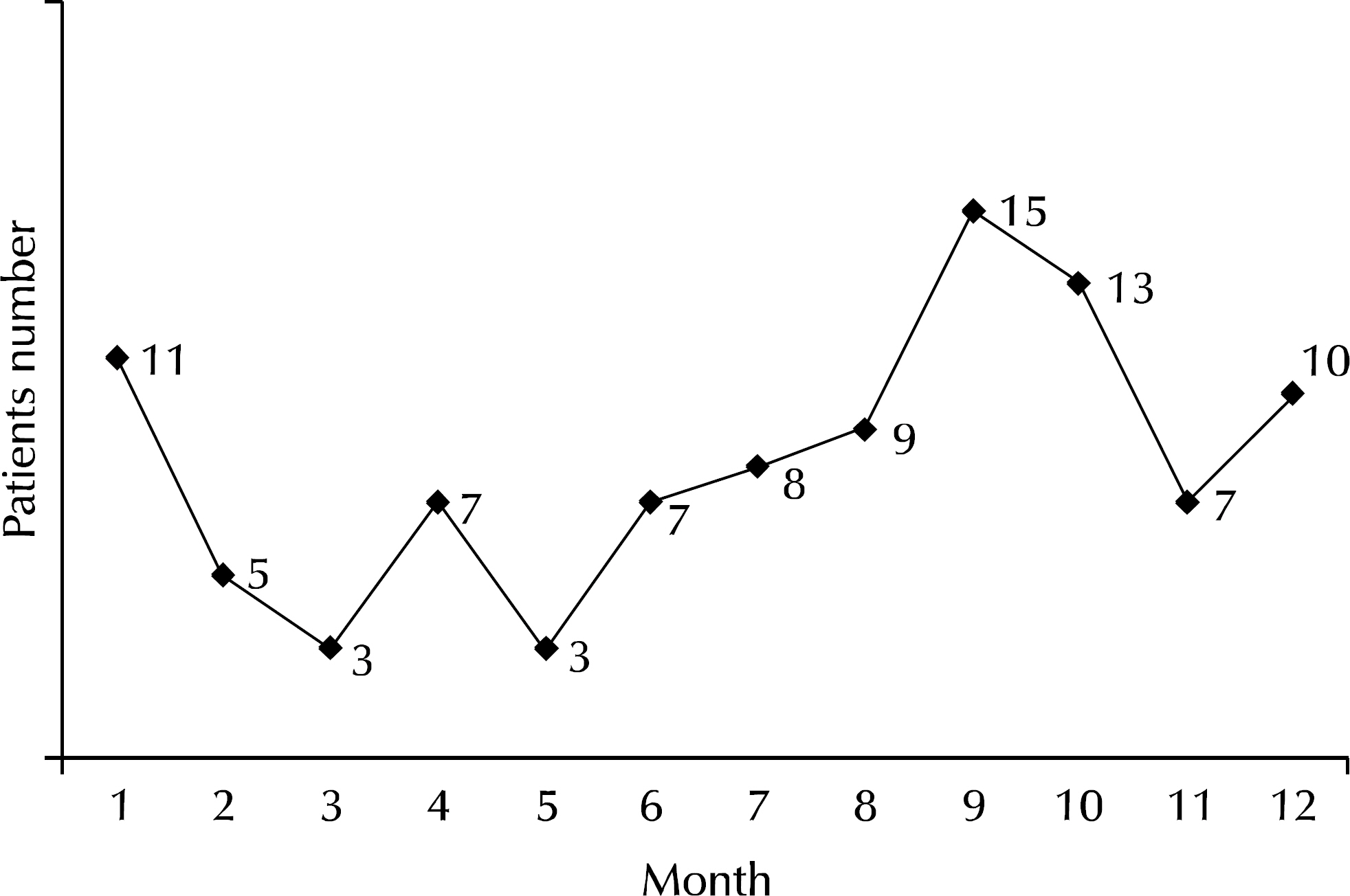Korean J Urogenit Tract Infect Inflamm.
2013 Apr;8(1):43-46. 10.14777/kjutii.2013.8.1.43.
Outbreaks and Seasonal Variation of Mumps Orchitis: Report of Multicenter Data in Korea
- Affiliations
-
- 1Department of Urology, Korea University College of Medecine, Seoul, Korea. urobae@genetherapy.or.kr
- 2Department of Urology, Chonnam National University Medical School, Gwangju, Korea.
- 3Department of Urology, National Police Hospital, Seoul, Korea.
- 4Department of Urology, Chung-Ang University College of Medicine, Seoul, Korea.
- 5Department of Urology, Chungnam National University School of Medicine, Daejeon, Korea.
- 6Department of Urology, Dankook University Medical College, Cheonan, Korea.
- KMID: 2289252
- DOI: http://doi.org/10.14777/kjutii.2013.8.1.43
Abstract
- PURPOSE
Mumps is an infectious viral disease that often results in painful swelling of testis preceded by parotitis. We report multicenter data on mumps orchitis from five community hospitals.
MATERIALS AND METHODS
From January 2011 to December 2012, 98 patients diagnosed with acute mumps orchitis were treated at five community hospitals in different districts of Korea. As a report on an outbreak of mumps orchitis, age, bilaterality, monthly occurrence frequency, and vaccination status were recorded retrospectively.
RESULTS
The mean age of the 98 patients was 19.7 (range from 10 to 38) years old. Age distribution of patients included 60 teens (61.2%), 31 in their twenties (31.6%), and seven in their thirties (7.2%). No evidence of a previous mumps vaccination was found in medical records from six patients (6.1%), and the vaccination status of one patient was unknown. Bilateral orchitis was noted in eight patients (8.2%), and 90 patients (91.8%) had unilateral orchitis. Right-sided orchitis was noted in 50 patients (51.0%), and left-sided orchitis was noted in 40 patients (40.8%). Autumn (September to November) was the most prevalent season, with 35 outbreaks (35.7%). Seasonal outbreaks occurred in 13 patients (13.2%) in spring (3rd-5th), 24 patients (24.7%) in summer (6th-8th), and 26 patients (26.4%) in winter (12th-2nd).
CONCLUSIONS
In spite of continued vaccination, mumps orchitis is still a prevalent disease. Therefore, due to a large number of outbreaks, mumps orchitis should still be considered, especially in teenagers and during autumn season. Conduct of additional long-term follow-up and large prospective studies is needed in Korea.
Keyword
MeSH Terms
Figure
Reference
-
1. Yvonne M. Mumps. Richard EB, Robert MK, Hal BJ, editors. Nelson textbook of pediatrics. 17th ed.Philadelphia: Saunders;2004. p. 1035–6.2. Muhlemann K. The molecular epidemiology of mumps virus. Infect Genet Evol. 2004; 4:215–9.3. Baum SG, Litman N. Mumps virus. Mandell GL, Douglas RG, Bennett JE, editors. Principle and practice of infectious disease. 3rd ed.New York: Churchill Livingstone;1990. p. 1260–4.4. Choi YM, Kim CH, Seo JG, Son YM, Oh SH, Lee WJ, et al. Measle, mumps, rubella (MMR) vaccination: guide to vaccinations. 2nd ed.Seoul: Jungmoonsa Inc.;1992. p. 48–54.5. Davis NF, McGuire BB, Mahon JA, Smyth AE, O'Malley KJ, Fitzpatrick JM. The increasing incidence of mumps orchitis: a comprehensive review. BJU Int. 2010; 105:1060–5.
Article6. Hviid A, Rubin S, Muhlemann K. Mumps. Lancet. 2008; 371:932–44.
Article7. Kim DH, Lee NK, Park YH. Effects of systemic treatment with interferon-alpha2b for mumps orchitis. Korean J Urol. 1995; 36:963–8.8. Yeniyol CO, Sorguc S, Minareci S, Ayder AR. Role of interferon-alpha-2B in prevention of testicular atrophy with unilateral mumps orchitis. Urology. 2000; 55:931–3.
Article9. Centers for Disease Control and Prevention (CDC). Mumps outbreak - New York, New Jersey, Quebec, 2009. MMWR Morb Mortal Wkly Rep. 2009; 58:1270–4.10. Lee JS, Ki MR, Sohn YM. Adverse events associated with MMR vaccination in Korea: prospect ive study using telephone surveillance method. Korean J Pediatr Infect Dis. 2000; 7:183–92.11. Kang HD, Lee KY, Cha SW, Yoon KN, Lee DJ, Han JW, et al. An outbreak of mumps in Taejon, Korea, 1998. Korean J Pediatr Infect Dis. 1999; 11:239–44.
Article12. Korean Center for Disease Control and Prevention. School based infectious disease surveillance report. Seoul: Korea Center for Disease Control and Prevention. 2000–2009.13. Korea Center for Disease Control & Prevention. 2004 Communicable diseases statistical yearbook. Seoul: Korea Center for Disease Control & Prevention. 2005. 8.14. Berman S. Epidemiology of acute respiratory infections in children of developing countries. Rev Infect Dis. 1991; 13(Suppl 6):S454–62.
Article15. Leland DS. Manual of clinical microbiology. 9th ed.Washington, DC: ASM Press;2007. p. 1352–60.16. Lee H, Lee CK, Nam MH, Roh KH, Yoon SY, Lim CS, et al. Epidemiologic features of parainfluenza virus type 1, 2 and 3 infection in Seoul and a neighboring area, 2008-2011. Korean J Clin Microbiol. 2012; 15:54–9.
Article
- Full Text Links
- Actions
-
Cited
- CITED
-
- Close
- Share
- Similar articles
-
- 2 Cases of Mumps Orchitis Treated with Systemic Interferon-alpha2
- Epidemiology of mumps, mumps complications, and mumps orchitis in Korea using the National Health Insurance Service database
- Late Mumps Orchitis: Clinical Manifestations in 20 cases Effect of Interferon-alpha2b
- Clinical Features of Mumps Orchitis in Vaccinated Postpubertal Males: A Single-Center Series of 62 Patients
- Effects of Systemic Treatment with Interferon-alpha2b for Mumps Orchitis


